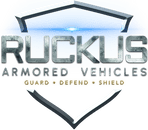If you are unsure of the protection level you require, give one of our specialists a call or email us for a risk assessment to determine the optimal protection level for your specific needs.
There are a wide variety of materials we can use when fortifying a vehicle in order to prevent harm to it's occupants. Traditional methods use very thick and quite heavy ballistic steel, whereas we prefer to make use of today's modern light-weight materials that offer equal or greater protection, better installation flexibility, and at a fraction of the weight.
The added weight varies based on the armoring material used, type of vehicle, protection level and the original chassis weight of the vehicle. We strive to always find the most optimal option to maintain the performance and maneuverability of our armored vehicles, regardless of added weight.
On any armored vehicle, it’s very important to ensure that all openings are well-protected. Ruckus offers armored vehicles with functional power windows, however they are usually restricted to 6” travel distance. This size of opening is large enough to pass packages or documents while minimizing potential exposure for the occupants.
As a result of the added weight, adjusted vehicle dimensions and special features, you will find that operating an armored vehicle is slightly different than a “soft-skin” vehicle. Depending on the requested armoring package, special training may be required.
Depending on the desired protection level, some of a vehicle’s components may need strengthening or reinforcement. With many years of experience in the industry, our engineering team is very capable of knowing in advance whether a vehicle’s suspension, braking or steering systems require additional modifications.
At Ruckus we offer special after-sale seminars and training workshops in order to educate our customers on the proper usage of their armored vehicles.
